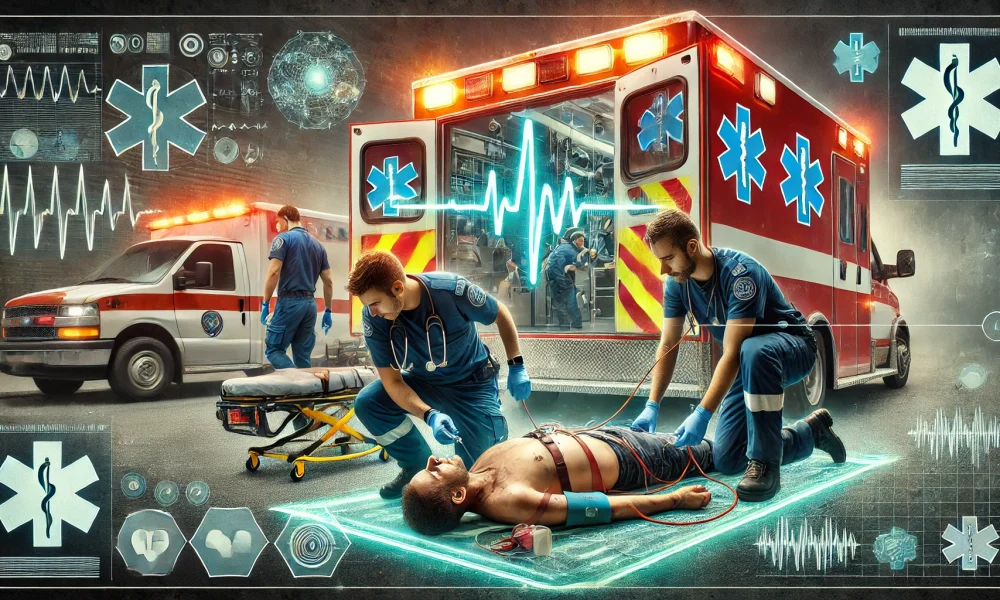Being a Paramedic is an unbelievably stressful job. Not only are they tasked with saving lives, but these frontline workers are constantly placed in unpredictable situations in every environment imaginable. They must remain personable yet assertive and work well as an individual and with allied services (Fire, Police, etc.). To top it all off, they must do this all while working irregular and long hours, while placing extreme stress on both their bodies and minds. Of all the calls Paramedics must attend, some of the most harrowing are those where they have little to no control over the outcome. An allergic reaction can be treated with medication; certain diabetic emergencies can be resolved with glucose; heart arrhythmias can be corrected with electrical intervention. However, when it comes to Cerebrovascular Accidents (CVAs) – commonly referred to as a ‘stroke,” there is little that can be done in the field.
Further complicating the situation when dealing with a CVA is the fact that treatment given for the most common form (ischemic) must be delivered within a relatively short time frame of under 4.5 hours. This may sound like a lot of time, but when taking into account the time it takes for Paramedics to arrive at the location, rule out possible causes, identify the issue at hand, and finally package the patient to transport to an Emergency Department, 4.5 hours go by a lot quicker than one may expect – especially in rural locations. This is why quick and early detection is paramount when dealing with a CVA.
Thankfully, with the advent of Artificial Intelligence (AI), Paramedics may have a new tool upon which they can rely in the coming years.
Turning Minutes into Seconds
A team of Biomedical Engineers from RMIT University has recently developed a new tool that leverages AI to identify a CVA in seconds, with a higher rate of accuracy than is currently possible in the field. Their paper, titled ‘Facial expressions to identify post-stroke: A pilot study‘, describes a smartphone app that can effectively assess a person’s facial features and determine whether there are signs of a CVA based on long-established signs such as unilateral facial drooping.
While much work needs to be done, early results were quite promising, with the AI-enabled solution accurately detecting post-stroke patients with an 82% success rate.
“With an accuracy of 82%, the results are promising. The analysis shows that Kiss and Spread are the best facial expressions to differentiate between healthy and post-stroke individuals, with muscles around the mouth most affected. The system is designed for unsupervised analysis of the videos, making it suitable for being developed as an app on a smartphone”
Part of what can make identifying a CVA difficult and time-consuming is that the process typically involves ruling out various alternative causes for a patient’s presentation. A few common conditions that may mimic a CVA include,
- hypoglycemia (low blood sugar)
- central nervous system infections (e.g., meningitis)
- severe hypertension and/or increased intracranial pressures (ICP)
- drugs (e.g., cocaine)
Once identified, pre-hospital care typically involves securing the patient’s airway, delivering oxygen if indicated, and rapid transport. What the patient needs is either an anti-clotting agent for ischemic CVAs or surgical intervention for Hemorrhagic CVAs.
By introducing so many variables, accuracy becomes more difficult in the field, and the most precious commodity (time) is spent. With every minute taking the patient closer to permanent brain damage, a solution proposed by the team of engineers could save countless lives around the world by making the jobs of Paramedics a little bit easier and more effective.
Companies Leveraging Artificial Intelligence in HealthCare
1. Alphabet Inc.
Alphabet’s Google Health division focuses on leveraging AI to enhance healthcare. It is developing AI algorithms for diagnosing diseases from medical imaging, predicting patient outcomes, and personalizing treatment plans. One notable project is the use of AI to detect diabetic retinopathy and breast cancer with high accuracy from medical images.
Another initiative associated with Alphabet is through one of its subsidiaries, DeepMind. This company, which is also at the forefront of AI in healthcare, is working on projects that use AI to predict patient deterioration and develop protein structure prediction models that can accelerate drug discovery.
2. IBM Corporation
IBM Watson Health applies AI and data analytics to various healthcare challenges. Its AI-driven solutions aim to improve clinical decision-making, enhance patient care, and optimize operations. Watson Health’s Oncology and Genomics solutions help oncologists develop personalized cancer treatment plans by analyzing vast amounts of medical literature and genetic data.
Through its Clinical Development initiative, IBM also uses AI to streamline the clinical trial process, improving data management and reducing time-to-market for new therapies.
Beyond CVAs
Interestingly, the team of engineers behind this initiative believe that, in time, the software may be able to accurately identify other neurological conditions that present by effecting facial expressions. A few examples of conditions that fit the bill are,
- Bell’s Palsy
- Parkinson’s
- Myasthenia Gravis
- Amyotrophic Lateral Sclerosis (ALS)
Team leader Professor Dinesh Kumar, has stated that,
“We want to be as sensitive and specific as possible. We are now working towards an AI tool with additional data and where we are going to be considering other diseases as well…Collaboration with healthcare providers will be crucial to integrate this App into existing emergency response protocols, providing paramedics with an effective means of early stroke detection.”
For now, let’s hope that this product can be perfected and come to fruition, as it could play an important role in both saving lives and preserving the quality of life of countless CVA sufferers every year.
